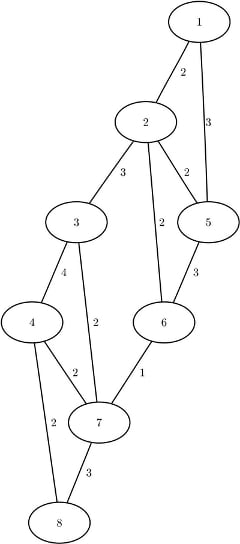The OPTNET Procedure
- Overview
-
Getting Started

-
Syntax
 Functional SummaryPROC OPTNET StatementBICONCOMP StatementCLIQUE StatementCONCOMP StatementCYCLE StatementDATA_LINKS_VAR StatementDATA_MATRIX_VAR StatementDATA_NODES_VAR StatementLINEAR_ASSIGNMENT StatementMINCOSTFLOW StatementMINCUT StatementMINSPANTREE StatementSHORTPATH StatementTRANSITIVE_CLOSURE StatementTSP Statement
Functional SummaryPROC OPTNET StatementBICONCOMP StatementCLIQUE StatementCONCOMP StatementCYCLE StatementDATA_LINKS_VAR StatementDATA_MATRIX_VAR StatementDATA_NODES_VAR StatementLINEAR_ASSIGNMENT StatementMINCOSTFLOW StatementMINCUT StatementMINSPANTREE StatementSHORTPATH StatementTRANSITIVE_CLOSURE StatementTSP Statement -
Details
 Graph Input DataMatrix Input DataNumeric LimitationsSize LimitationsBiconnected Components and Articulation PointsCliqueConnected ComponentsCycleLinear Assignment (Matching)Minimum-Cost Network FlowMinimum CutMinimum Spanning TreeShortest PathTransitive ClosureTraveling Salesman ProblemMacro VariablesODS Table Names
Graph Input DataMatrix Input DataNumeric LimitationsSize LimitationsBiconnected Components and Articulation PointsCliqueConnected ComponentsCycleLinear Assignment (Matching)Minimum-Cost Network FlowMinimum CutMinimum Spanning TreeShortest PathTransitive ClosureTraveling Salesman ProblemMacro VariablesODS Table Names -
Examples
 Articulation Points in a Terrorist NetworkCycle Detection for Kidney Donor ExchangeLinear Assignment Problem for Minimizing Swim TimesLinear Assignment Problem, Sparse Format versus Dense FormatMinimum Spanning Tree for Computer Network TopologyTransitive Closure for Identification of Circular Dependencies in a Bug Tracking SystemTraveling Salesman Tour through US Capital Cities
Articulation Points in a Terrorist NetworkCycle Detection for Kidney Donor ExchangeLinear Assignment Problem for Minimizing Swim TimesLinear Assignment Problem, Sparse Format versus Dense FormatMinimum Spanning Tree for Computer Network TopologyTransitive Closure for Identification of Circular Dependencies in a Bug Tracking SystemTraveling Salesman Tour through US Capital Cities - References
A cut is a partition of the nodes of a graph into two disjoint subsets. The cut-set is the set of links whose from and to nodes are in different subsets of the partition. A minimum cut of an undirected graph is a cut whose cut-set has the smallest link metric, which is measured as follows: For an unweighted graph, the link metric is the number of links in the cut-set. For a weighted graph, the link metric is the sum of the link weights in the cut-set.
In PROC OPTNET, you can invoke the minimum-cut algorithm by using the MINCUT statement. The options for this statement are described in the section MINCUT Statement. This algorithm can be used only on undirected graphs.
If the value of the MAXNUMCUTS= option is greater than 1, then the algorithm can return more than one set of cuts. The resulting
cuts can be described in terms of partitions of the nodes of the graph or the links in the cut-sets. The node partition is
specified by the mincut_i variable, for each cut i, in the data set that is specified in the OUT_NODES= option in the PROC OPTNET statement. Each node is assigned the value
0 or 1, which defines the side of the partition to which it belongs. The cut-set is defined in the output data set that is
specified in the OUT= option in the MINCUT statement. This data set lists the links and their weights for each cut.
The minimum-cut algorithm reports status information in a macro variable called _OROPTNET_MINCUT_. See the section Macro Variable _OROPTNET_MINCUT_ for more information about this macro variable.
PROC OPTNET uses the Stoer-Wagner algorithm (Stoer and Wagner 1997) to compute the minimum cuts. This algorithm runs in time ![]() .
.
As a simple example, consider the weighted undirected graph in Figure 2.42.
The links data set can be represented as follows:
data LinkSetIn; input from to weight @@; datalines; 1 2 2 1 5 3 2 3 3 2 5 2 2 6 2 3 4 4 3 7 2 4 7 2 4 8 2 5 6 3 6 7 1 7 8 3 ;
The following statements calculate minimum cuts in the graph and output the results in the data set MinCut:
proc optnet
loglevel = moderate
out_nodes = NodeSetOut
data_links = LinkSetIn;
mincut
out = MinCut
maxnumcuts = 3;
run;
%put &_OROPTNET_;
%put &_OROPTNET_MINCUT_;
The progress of the procedure is shown in Figure 2.43.
Figure 2.43: PROC OPTNET Log for Minimum Cut
| NOTE: ------------------------------------------------------------------------------------------ |
| NOTE: ------------------------------------------------------------------------------------------ |
| NOTE: Running OPTNET version 13.2. |
| NOTE: ------------------------------------------------------------------------------------------ |
| NOTE: ------------------------------------------------------------------------------------------ |
| NOTE: Reading the links data set. |
| NOTE: There were 12 observations read from the data set WORK.LINKSETIN. |
| NOTE: Data input used 0.01 (cpu: 0.00) seconds. |
| NOTE: Building the input graph storage used 0.00 (cpu: 0.00) seconds. |
| NOTE: The input graph storage is using 0.0 MBs of memory. |
| NOTE: The number of nodes in the input graph is 8. |
| NOTE: The number of links in the input graph is 12. |
| NOTE: ------------------------------------------------------------------------------------------ |
| NOTE: ------------------------------------------------------------------------------------------ |
| NOTE: Processing the minimum-cut problem. |
| NOTE: The minimum-cut algorithm found 3 cuts. |
| NOTE: The cut 1 has weight 4. |
| NOTE: The cut 2 has weight 5. |
| NOTE: The cut 3 has weight 5. |
| NOTE: Processing the minimum-cut problem used 0.00 (cpu: 0.00) seconds. |
| NOTE: ------------------------------------------------------------------------------------------ |
| NOTE: ------------------------------------------------------------------------------------------ |
| NOTE: Creating nodes data set output. |
| NOTE: Creating minimum-cut data set output. |
| NOTE: Data output used 0.00 (cpu: 0.00) seconds. |
| NOTE: ------------------------------------------------------------------------------------------ |
| NOTE: ------------------------------------------------------------------------------------------ |
| NOTE: The data set WORK.NODESETOUT has 8 observations and 4 variables. |
| NOTE: The data set WORK.MINCUT has 6 observations and 4 variables. |
| STATUS=OK MINCUT=OPTIMAL |
| STATUS=OPTIMAL OBJECTIVE=4 CPU_TIME=0.00 REAL_TIME=0.00 |
The data set NodeSetOut now contains the partition of the nodes for each cut, shown in Figure 2.44.
The data set MinCut contains the links in the cut-sets for each cut. This data set is shown in Figure 2.45, which also shows each cut separately.
